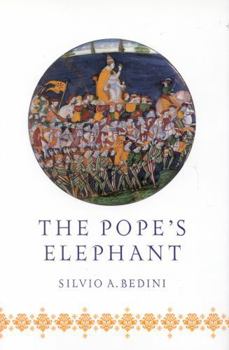The Pope's Elephant
Select Format
Select Condition 
Book Overview
In this tour de force of original scholarship, Silvio Bedini gives us an elephant's-back view of early modern Europe. "Combines offbeat charm with historical rigor to pleasing effect."--The Independent on Sunday.
Format:Hardcover
Language:English
ISBN:1879941414
ISBN13:9781879941410
Release Date:October 1998
Publisher:J. S. Sanders and Company
Length:312 Pages
Weight:1.20 lbs.
Dimensions:1.0" x 6.1" x 9.3"
Customer Reviews
3 ratings
THIS is how historiography is done
Published by Thriftbooks.com User , 21 years ago
If you've even a passing interest in historiography - supplementing the historical record with artifacts and peripherally supporting documentary evidence to glean a substantial picture of the world represented by written history - you will find this book a treasure. At times shocking, at others moving, often repellant and even more frequently laugh-out-loud audacious, it is always illuminating. This is high scholarship, but only very rarely is it dry. Good for the gothic audience: never again will you dream of living in romantic 16th C Europe, not after the smells and sounds and horrific displays of human behavior brought to life by Bedini and the story of the elephant/s.
The Short, Strange Life of a Very Large Animal (Pope Leo X)
Published by Thriftbooks.com User , 23 years ago
The Pope's Elephant by Silvio A. Bedini is a fun book although it does not quite deliver the promise of the subtitle on the cover. It is not really about the journey of an elephant from deep in India to the heart of Rome. It is really about the strange workings of Rome and the Papacy in the early 1500's and their dealings with other nations, such as Portugal from which the ill-fated elephant, Hanno, arrives. The author uses a great variety of sources for this journey, particulary interesting being the use made of contemporary artists to provide proof of events. This book could have used the Pope's elephant for a much wider glimpse of the world at this point in time, but the more narrow version presented here is fascinating and illuminating in its own right. An interesting footnote into history (and, truly, how many interesting footnotes does one run across).
The Pope's Elephant: Prize of the Vatican's Menagerie
Published by Thriftbooks.com User , 24 years ago
"Rome produces its monkeys and wild goats And every type of wild beast, more even than India and Africa. And now that Leo has become their king, All the animals, even the very elephant, Must hold him in honour."A verse of Pasquino heralds the arrival of the great elephant Hanno to Rome, where it is presented to Pope Leo X. And so begins Silvio Bedini's delightful story of the pope's elephant. Bedini, whose work has covered a range of topics in the past, began exploring the rumors of a Vatican rhinoceros and elephant, only to find them not only true, but part of a fantastic story of imperial representations of power, patronage, gift-giving, and ceremony. Brought to Leo X 1514, Hanno the elephant was a symbol of Portuguese power and dominance in the far east, and particularly from India, where the elephant's journey began. Bedini details the long voyage from Lisbon to Porto Ecole, during which the elephant was anchored between the two masts of the boat. From there, the travel to Rome via dirt roads is complicated both by wear on the elephant's tender feet and the throngs of people who crowd the entourage, trying to get a look at the most spectacular gift. In Rome, the elephant is finally, and formally, handed over to the pope, and Bedini shows his remarkable descriptive skill in sketching out every aspect of the ceremony. Those interested in the rituals of such religious, nationalistic and political events (all bundled into one) will be satisfied with Bedini's work here. Once in Rome and rested, Hanno becomes a living symbol of the period, captured by poets, playwrights, and artists. Oddly, the elephant shared a small amount of fame with a rhinoceros, another gift from the Portuguese. The fate of this beast, however, is less well known, and while it appears in several commissioned paintings from the period, its fate remains unclear. The book closes with the death of Leo X, and the changes which ensued, both religiously and culturally, after his passing. Bedini thoughtfully examines the influence of this pope and his large beast on the belles lettres of the period. Beautiful plates show the extent to which the elephant--as a symbol of the Church's strength, of the Pope's magnificence, and of the animal's own divine purpose--captivated people, and the reader is given a new perspective on the 16th century, simply by focusing on an elephant.





